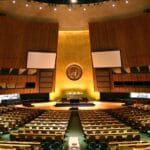End the 67-year war
By Robert Alvarez | September 11, 2017
It’s time to find a path to end the 67-year-long Korean war. As the threat of military conflict looms, the American public is largely unaware of the sobering facts about America’s longest unresolved war and one of the world’s bloodiest. The 1953 armistice agreement engineered by President Eisenhower—halting a three-year-long “police action” that resulted in two million to four million military and civilian deaths—is long forgotten. Struck by military leaders of North Korea, the United States, South Korea, and their United Nations allies to halt fighting, the armistice was never followed up by a formal peace agreement to end this conflict of the early Cold War.
A State Department official reminded me of this unsettled state of affairs before I traveled to the Youngbyon nuclear site in November 1994 to help secure plutonium-bearing spent reactor fuel as part of the Agreed Framework between the United States and North Korea. I had suggested that we take space heaters to the spent fuel pool storage area, to provide warmth for the North Koreans who would be working during winter to place highly radioactive spent fuel rods in containers, where they could be subject to International Atomic Energy Agency (IAEA) safeguards. The State Department official became upset. Even 40 years after the end of hostilities, we were forbidden to provide any comfort to the enemy, regardless of the bitter cold interfering with their—and our—task.
How the Agreed Framework collapsed. In the spring and summer of 1994, the United States was on a collision course with North Korea over its efforts to produce the plutonium to fuel its first nuclear weapons. Thanks in large part to the diplomacy of former President Jimmy Carter, who met face-to-face with Kim Il Sung, the founder of the Democratic People’s Republic of Korea (DPRK), the world pulled away from the brink. Out of this effort sprang the general outlines of the Agreed Framework, signed on October 12, 1994. It remains the only government-to-government accord ever made between the United States and North Korea.
The Agreed Framework was a bilateral non-proliferation pact that opened the door to a possible end of the Korean war. North Korea agreed to freeze its plutonium production program in exchange for heavy fuel oil, economic cooperation, and the construction of two modern light-water nuclear power plants. Eventually, North Korea’s existing nuclear facilities were to be dismantled and the spent reactor fuel taken out of the country. South Korea played an active role in helping prepare for the construction of the two reactors. During its second term in office, the Clinton administration was moving towards establishing a more normalized relationship with the North. Presidential advisor Wendy Sherman described an agreement with North Korea to eliminate its medium and long-range missiles as “tantalizingly close” before negotiations were overtaken by the 2000 presidential election.
But the framework was bitterly opposed by many Republicans, and when the GOP took control of Congress in 1995, it threw roadblocks in the way, interfering with fuel oil shipments to North Korea and the securing of the plutonium-bearing material located there. After George W. Bush was elected president, the Clinton administration’s efforts were replaced with an explicit policy of regime change. In his State of the Union address in January 2002, Bush declared North Korea a charter member of the “axis of evil.” In September, Bush expressly mentioned North Korea in a national security policy that called for preemptive attacks against countries developing weapons of mass destruction.
This set the stage for a bilateral meeting in October 2002, during which Assistant Secretary of State James Kelly demanded that North Korea cease a “secret” uranium enrichment program or face severe consequences. Although the Bush Administration asserted the enrichment program had not been disclosed, it was public knowledge—in the Congress and in the news media—by 1999. North Korea had strictly complied with the Agreed Framework, freezing plutonium production for eight years. Safeguards over uranium enrichment had been deferred in the agreement until sufficient progress was made in the development of the light water reactors; but if that delay was seen as dangerous, the agreement could have been amended. Shortly after Sullivan’s ultimatum, North Korea ended the safeguards program for its spent nuclear fuel and began to separate plutonium and produce nuclear weapons—igniting a full-blown crisis, just as the Bush administration was poised to invade Iraq.
In the end, the Bush administration’s efforts to resolve the impasse on North Korea’s nuclear program—aka the Six-Party Talks—failed, largely because of the United States’ adamant support for regime change in North Korea and persistent “all or nothing” demands for a complete dismantlement of the North’s nuclear program before serious negotiations could take place. Also, with the US presidential election nearing, the North Koreans had to have remembered how abruptly the plug had been pulled on the Agreed Framework after the 2000 election.
By the time President Obama took office, North Korea was well on its way to becoming a nuclear weapons state and was reaching the threshold of testing intercontinental ballistic missiles. Described as “strategic patience,” Obama’s policy was to a large extent influenced by the pace of nuclear and missile development, particularly as Kim Jong-un, the founder’s grandson, ascended to power. Under the Obama administration, economic sanctions and increased-duration joint military exercises were met with intensified North Korean provocations. Now, under the Trump administration, the joint military exercises by the United States, South Korea and Japan—intended to demonstrate the “fire and fury” that could destroy the DPRK regime—appear to have only accelerated the pace at which North Korea has stepped up its long-range missile testing and detonation of more powerful nuclear weapons.
Dealing with the nuclear weapons state of North Korea. The seeds for a nuclear-armed DPRK were planted when the United States shredded the 1953 Armistice Agreement. Beginning in 1957, the US violated a key provision of the agreement (paragraph 13d), which barred the introduction of more destructive armaments to the Korean peninsula, by ultimately deploying thousands of tactical nuclear weapons in South Korea, including atomic artillery shells, missile-launched warheads and gravity bombs, atomic “bazooka” rounds and demolition munitions (20 kiloton “back-pack” nukes). In 1991, then-President George H.W. Bush withdrew all the tactical nukes. In the 34 intervening years, however, the United States unleashed a nuclear arms race—among the branches of its own its own military on the Korean Peninsula! This massive nuclear buildup in the South provided a major impetus for North Korea to forward-deploy a massive conventional artillery force that can destroy Seoul.
Now, some South Korean military leaders are calling for the redeployment of US tactical nuclear weapons in the country, which would do nothing but exacerbate the problem of dealing with a nuclear North Korea. The presence of US nuclear weapons did not deter a surge in aggression by North Korea in the 1960s and 1970s, an era known as the “Second Korean War,” during which more than 1,000 South Korean and 75 American soldiers were killed. Among other actions, North Korean forces attacked and seized the Pueblo, a US Naval intelligence vessel, in 1968, killing a crew member and capturing 82 others. The ship was never returned.
North Korea has long pushed for bilateral talks that would lead to a non-aggression pact with the United States. The US government has routinely spurned its requests for a peace agreement because they are perceived as tricks designed to reduce the US military presence in South Korea, allowing for even more aggression by the North. The Washington Post’s Jackson Diehl echoed this sentiment recently, asserting that North Korea is not really interested in a peaceful resolution. While citing a statement by North Korean Deputy UN Ambassador Kim In Ryong that his country “will never place its self-defensive nuclear deterrence on the negotiating table,” Diehl conveniently omitted Ryong’s important caveat: “as long as the US continues to threaten it.”
Over the past 15 years, military exercises in preparation for war with North Korea have increased in extent and duration. Recently, Trevor Noah, host of Comedy Central’s much-watched The Daily Show, asked Christopher Hill, chief US negotiator for the Six-Party talks during the George W. Bush years, about the military exercises; Hill declared that “we never have planned to attack” North Korea. Hill was either ill-informed or dissembling. The Washington Post reported that a military exercise in March 2016 was based on a plan, agreed to by the United States and South Korea, that included “preemptive military operations” and “‘decapitation raids’ by special forces targeting the North’s leadership.” In the Washington Post article, a US military expert did not dispute the plan’s existence but said it has a very low probability of being implemented.
Regardless of how likely they are to ever be implemented, these annual wartime planning exercises help perpetuate and perhaps even strengthen the brutal coercion by the North Korean leadership of its people, who live in constant fear of an imminent war. During our visits to North Korea, we observed how the regime inundated its citizens with reminders about the carnage caused by napalm that US aircraft had dropped during the war. By 1953, US bombing had destroyed nearly all structures in North Korea. Dean Rusk, Secretary of State during the Kennedy and Johnson administrations, said several years later that bombs were dropped on “everything that moved in North Korea, every brick standing on top of another.” Over the years, the North Korean regime has developed a vast system of underground tunnels used in frequent civil defense drills.
It’s probably too late to expect the DPRK to relinquish its nuclear arms. That bridge was destroyed when the Agreed Framework was discarded in the failed pursuit of regime change, a pursuit that not only provided a powerful incentive but also plenty of time for the DPRK to amass a nuclear arsenal. Secretary of State Tillerson recently stated that “we do not seek a regime change, we do not seek collapse of the regime.” Unfortunately, Tillerson has been drowned out by coverage of belligerent tweets by President Trump and sabre-rattling by former military and intelligence officials.
In the end, a peaceful resolution to the North Korean nuclear situation will involve direct negotiations and gestures of good faith by both sides, such as a reduction or a halt of military exercises by the United States, South Korea, and Japan, and a reciprocal moratorium on nuclear weapon and ballistic missile testing by the DPRK. Such steps will generate a great deal of opposition from US defense officials who believe that military might and sanctions are the only forms of leverage that will work against the North Korean regime. But the Agreed Framework and its collapse provide an important lesson about the pitfalls of the pursuit of regime change. Now, a nuclear arms control agreement may be the only way to bring this over-long chapter of the Cold War to a peaceful close. It’s difficult to persuade someone to make a deal, if he is certain you’re planning to kill him, no matter what he does.
Together, we make the world safer.
The Bulletin elevates expert voices above the noise. But as an independent nonprofit organization, our operations depend on the support of readers like you. Help us continue to deliver quality journalism that holds leaders accountable. Your support of our work at any level is important. In return, we promise our coverage will be understandable, influential, vigilant, solution-oriented, and fair-minded. Together we can make a difference.
Topics: Columnists, Nuclear Weapons















